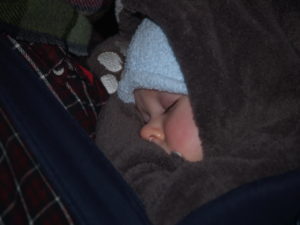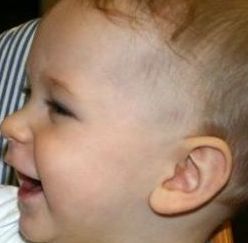Overstimulation in Infancy
OVERVIEW

Overstimulation in children is a broad topic ranging from overstimulation in infants to children on the spectrum, to children in war-torn countries, and other traumatized children such as those faced with terrors due to 9-11, including post-traumatic-stressors.
To narrow the topic, I will focus on infancy. Healthy infants from the first few seconds after birth are stimulated by sound, particularly recognizing their mother’s voice, and within days to sounds around them, environmental movements, and of course, hunger.
Parents quickly become acute observers of their infant’s body language that speaks to them about how much stimulation they need and when it’s too much.
It’s easy to identify an over-stimulated baby because she will avert her head from her mother’s voice if it is too loud for her. She will turn her head from the nipple when she needs a breath or is satiated. Sudden sounds may perk some babies up and lead others to cry. Some babies are overstimulated by the sounds of a vacuum or dishwasher; others take these daily sounds as just part of their ambient environment.
We can’t totally shield babies from too much sound exposure and visual exposure, but if we are careful observers, we’ll catch on how to introduce incrementally everyday sounds and sights.
Behavior is a Messenger
 A baby’s language is understood by recognizing that their behaviors, sometimes even the slightest movements, send a message needed to be heard by their mom or dad. As the early months roll by, the baby’s need for and aversion to various stimuli change often rapidly. If a parent sees their role not only as nurturer and provider of safety, shelter, food, and love, they will become attuned to the different levels of stimulation their baby needs and avoids.
A baby’s language is understood by recognizing that their behaviors, sometimes even the slightest movements, send a message needed to be heard by their mom or dad. As the early months roll by, the baby’s need for and aversion to various stimuli change often rapidly. If a parent sees their role not only as nurturer and provider of safety, shelter, food, and love, they will become attuned to the different levels of stimulation their baby needs and avoids.
It is repeatedly observed that from the start, newborns show rooting, sucking, molding, and orienting. They track moving objects visually. The most important and exciting moving object is you, the parent’s face.
You’ll see your baby’s eyes widen with your facial expressions. So when is the baby over-stimulated?
When your facial expression for your particular baby elicits a head turn or a cry or wiggly hands and feet that seem to last too long, simply temper your expression to a more familiar look, and you’ll see your baby adjust quickly
Your Internal Feelings Impact Stimulation of Your Baby

Remarkably, and much earlier than was first thought, your infant can not only match your external behavior but also capture the quality of your internal feelings. This means your internal feelings can overstimulate your baby. You can never be a blank slate, nor should you be, so you will notice how and when your baby adapts to your states’ of mind. Nervous chatter, explosive laughter, and even mild tearfulness coming from a mother will affect her baby. You will know because the baby’s gestures shift and change from calm to over-excited.
A natural tendency to “tell” your baby to calm won’t work unless your tone changes to a calm one. If your nervous chatter on the phone seems to stir your baby from her sleep, simply lowering your voice, and gently patting her back or humming softly will bring the resumption of her sleep.
In other words, you and your baby are very attuned to each other, which raises and lowers levels of stimulation.
- Your baby feels if you are sad, happy, excited, or relaxed. Consequently, your moods, even when you are barely aware of them, affect your baby’s temperament. The temperament of infants can vary greatly and, therefore, different babies are variously impacted by their parents’ moods.
Some infants can dampen (lessen) their arousal and inhibit their behavior on their own if they feel overstimulated. This may be seen as an infant turns away or begins to look sleepy. One of a parent’s tasks is to assist their baby’s capacity to self-regulate stimulation. Your baby learns to respond to the outside environment and soothe herself, believe it or not, even in utero—before you meet face to face. So this process is just continuing after birth.
Mental Separation
Jumping ahead, at approximately five months, babies begin to experience a gradual—but significant—mental separation. That is an understanding of their boundaries as an individual. You, mother and father, are increasingly viewed as an individual, separate from the baby.

What does that have to do with over-stimulation? If your separation physically is too abrupt for your particular baby, it may feel to your infant that you have vanished. That’s overstimulating. This is why we gradually separate at bedtime with carefully planned rituals that prepare our baby to sleep on her own.
Play and Sensory Stimulation
Play involves stimulating learning and helps a baby form a sense of self. The baby learns with his body as you interact with his fingers and toes. He begins to recognize that something that can be seen, touched, or heard can be the same thing.

At this point, overstimulation can take place because the senses are working together now at top speed. Furthermore, some senses take priority in the baby’s mind over others. When the baby hears a rattle and sees lips talking at the same time, he will pursue the lips before the rattle.
That is, sight trumps sound. If the visual is too exciting for your baby’s temperament, you’ll notice he can’t tolerate increasing sound-making as well. The tip for a parent is to realize that these various sensory inputs impact each other, and all a mommy has to do is temper one sensory input at a time.
Conclusion

Over-stimulation is not always traumatic due to an environmental event that is clearly dramatic. This is obvious in wartime, for example. But overstimulation can be a daily event that a mother and father, attuned to their baby’s sensory sensitivities, can temper easily and effectively.
The vivid gaping smile of the child above is a perfect picture of a stimulated, self-regulated, happy child whose infancy went beautifully.